- Last Updated: January 15th, 2026
Key Takeaways
The Ozempic lawsuit alleges that Novo Nordisk failed to adequately warn patients about the severe side effects of Ozempic, including gastrointestinal issues, thyroid tumors, and cardiovascular risks, leading to a class action lawsuit.
To file an Ozempic lawsuit, plaintiffs must prove that they experienced severe side effects directly linked to the drug, gather supporting medical evidence, and consult with an experienced attorney specializing in pharmaceutical cases to navigate the legal process.
Potential compensation in an Ozempic lawsuit may include medical expenses, lost wages, pain and suffering, and loss of consortium, with factors such as the severity of injuries, medical documentation, and the defendant's conduct influencing the settlement amounts.
Overview of the Ozempic Lawsuit
On this page, we’ll discuss the Ozempic Lawsuit, eligibility criteria for filing an Ozempic Lawsuit, steps involved in filing an Ozempic Lawsuit, and much more.
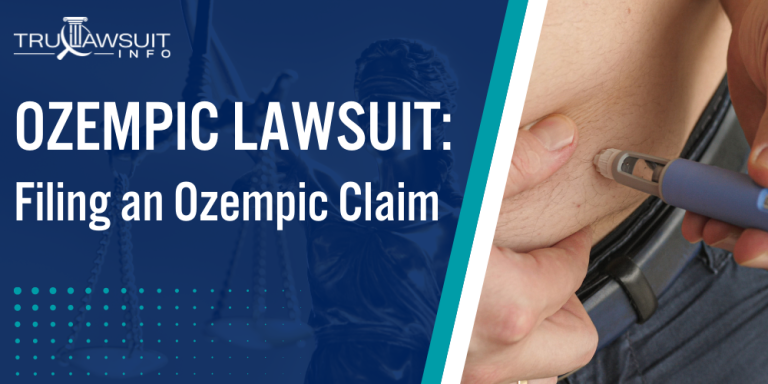
Intro to the Ozempic Lawsuit
Key aspects of the lawsuit include:
- Plaintiffs Alleging Severe Side Effects: Many individuals have reported experiencing serious gastrointestinal problems after taking Ozempic.
- Lack of Adequate Warnings: Allegations state that Novo Nordisk did not sufficiently warn users about potential severe side effects.
- Focus on Disclosure and Liability: The Ozempic litigation questions whether Novo Nordisk should be held liable for failing to provide proper warnings about Ozempic’s risks.
- Ozempic for Type 2 Diabetes: Despite the controversies, doctors have prescribed Ozempic to treat type-2 diabetes.
If you or a loved one has suffered from severe side effects like stomach paralysis or thyroid tumors after taking Ozempic, you may be eligible for compensation.
Contact TruLawsuit Info using the chat on this page to receive an instant case evaluation and determine whether you qualify to file an Ozempic lawsuit.
Potential Side Effects and Risks of Ozempic
Patients taking Ozempic, a semaglutide drug, often report various side effects ranging from mild to severe.
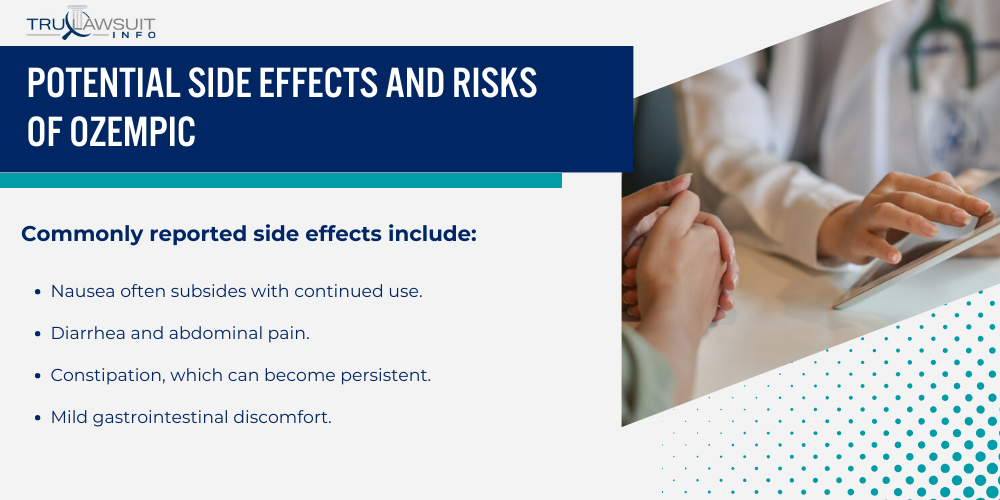
Below are some of the most commonly reported side effects, as well as the severe adverse reactions that have led to numerous complaints and lawsuits.
Common Side Effects Reported by Ozempic Users
Ozempic, primarily used for weight loss and managing blood sugar levels, has several side effects frequently observed among its users.
Commonly reported side effects include:
- Nausea often subsides with continued use.
- Diarrhea and abdominal pain.
- Constipation, which can become persistent.
- Mild gastrointestinal discomfort.
These effects are typically seen in the initial phase of treatment and may decrease over time.
However, some patients have reported lingering issues even after prolonged use.
This persistent discomfort often leads to adjustments in dosage or discontinuation of the medication altogether.
Severe Adverse Reactions Linked to Ozempic Lawsuit
Companies manufacturing Ozempic face legal scrutiny due to severe adverse reactions linked to its use.
Severe reactions include:
- Severe gastrointestinal issues such as chronic nausea and vomiting.In casess of severe gastroparesis, the stomach’s ability to empty its contents is significantly affected.
- Increased risk of thyroid tumors and certain cancers, especially highlighted in the context of long-term use.
- Cardiovascular risks may include events such as heart attacks or strokes.
These severe side effects have led to multiple lawsuits against the drug’s manufacturers, particularly arguing that the Ozempic warning label did not adequately inform users of these potential dangers.
The ongoing Ozempic side effects lawsuit continues to highlight the need for transparent communication regarding the risks associated with semaglutide weight loss drugs.
These legal actions fall under what is known as multidistrict litigation (MDL), which aims to consolidate similar cases to streamline the judicial process.
Eligibility Criteria for Filing an Ozempic Lawsuit
To file an Ozempic class action lawsuit, plaintiffs need to understand the basis for legal action, determine if they qualify, and gather supporting evidence.
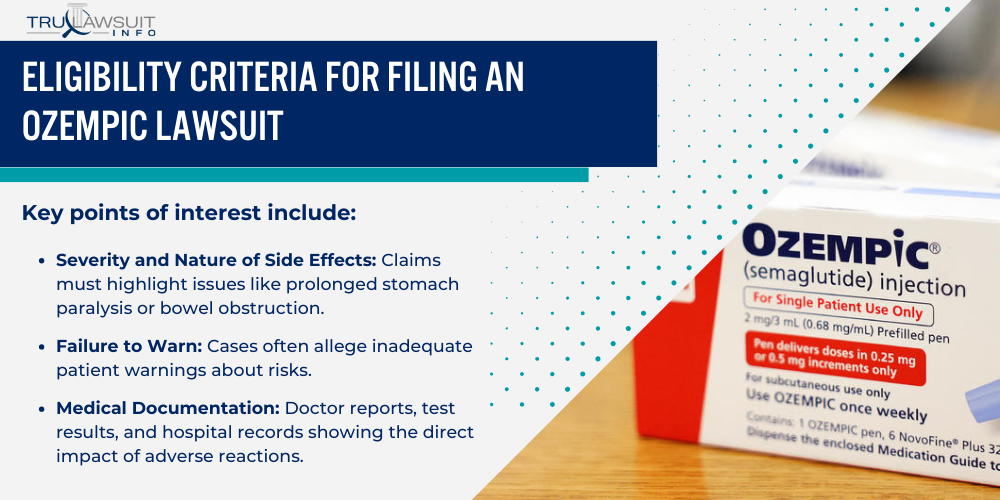
This section outlines these aspects specifically to aid prospective plaintiffs.
The Basis for Ozempic Lawsuits
Ozempic lawsuits commonly arise due to alleged adverse effects such as stomach paralysis and bowel obstructions linked to the semaglutide drug manufactured by Novo Nordisk and Eli Lilly.
Plaintiffs often claim that the drug companies failed to adequately warn patients about these severe side effects.
Key points of interest include:
- Severity and Nature of Side Effects: Claims must highlight issues like prolonged stomach paralysis or bowel obstruction.
- Failure to Warn: Cases often allege inadequate patient warnings about risks.
- Medical Documentation: Doctor reports, test results, and hospital records showing the direct impact of adverse reactions.
- History of Usage: Precise details on when and how the drug was used by the patient.
Understanding these points can help in forming the basis of a lawsuit.
Determining If You Qualify for an Ozempic Lawsuit
Individual plaintiffs must determine their eligibility through a few critical steps.
First, assess if the adverse effects are linked to Ozempic use and not other factors.
Factors to consider include:
- Documented Use of Ozempic: Records showing the duration and dosage of Ozempic use.
- Medical Diagnosis: Official diagnosis linking the health issue directly to Ozempic.
- Previous Health Conditions: Identifying pre-existing conditions that might alter the lawsuit’s validity.
- Legal Consultation: Engaging with a legal professional to understand your potential case specifics.
Federal multidistrict litigation processes may also help streamline cases against drug manufacturers, aiding in quicker resolution.
Gathering Evidence to Support Your Ozempic Lawsuit Claim
Supporting an Ozempic lawsuit requires solid evidence.
Plaintiffs must collect comprehensive documentation to build a strong case.
Evidence-gathering should focus on:
- Medical Records: Detailed records from healthcare providers showing the onset and treatment of ailments like stomach paralysis.
- Proof of Drug Purchase: Receipts or prescription records confirming the use of Ozempic.
- Expert Testimonies: Medical expert opinions linking the adverse effects to the drug.
- Personal Statements: Written personal accounts detailing the side effects experienced.
Collecting and organizing this evidence properly can significantly impact the lawsuit’s success.
Adherence to these criteria and diligent evidence gathering can help in pursuing a legal complaint.
Legal Grounds for Pursuing an Ozempic Lawsuit
Individuals who pursue an Ozempic MDL lawsuit may focus on areas such as proving negligence and establishing liability.
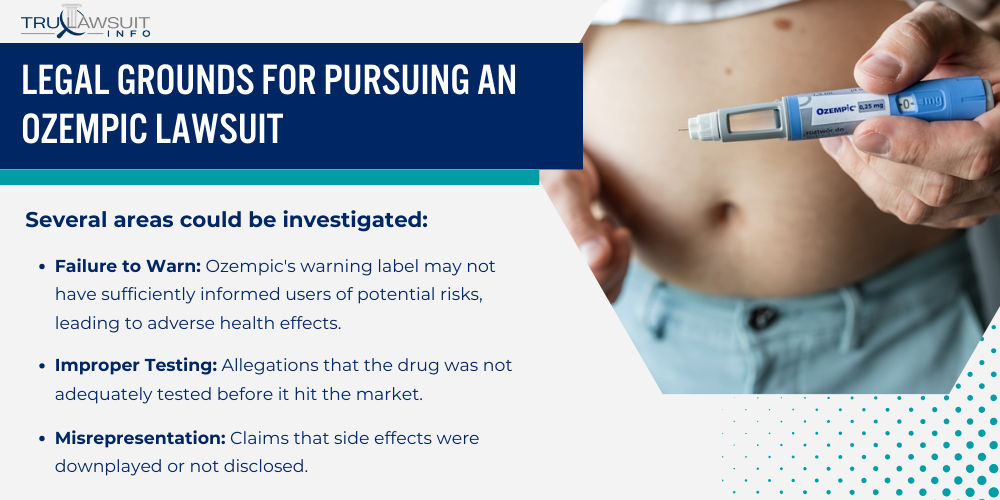
Both aspects are key to a successful legal proceeding.
Proving Negligence in Ozempic Lawsuit Cases
To prove negligence in an Ozempic lawsuit, plaintiffs must often demonstrate that Novo Nordisk, the drug’s manufacturer, failed to exercise reasonable care in its development or marketing.
Several areas could be investigated:
- Failure to Warn: Ozempic’s warning label may not have sufficiently informed users of potential risks, leading to adverse health effects.
- Improper Testing: Allegations that the drug was not adequately tested before it hit the market.
- Misrepresentation: Claims that side effects were downplayed or not disclosed.
- Manufacturing Defects: Issues related to errors in the drug production process.
Multidistrict litigation (MDL) may often arise, such as the Ozempic lawsuit MDL, to streamline numerous similar cases by consolidating them under a single federal court jurisdiction.
This is typical in mass tort litigation scenarios.
Establishing Liability in an Ozempic Lawsuit
Establishing liability involves proving that the defendant is legally responsible for any harm caused by their actions or product.
In an Ozempic lawsuit, plaintiffs need to show:
- Causation: Clear evidence that Ozempic use led to the injury or illness.
- Duty of Care: The manufacturer had a duty to ensure the product’s safety.
- Breach of Duty: The manufacturer breached this duty through negligence or oversight.
- Damages: The plaintiff suffered quantifiable harm due to the diabetes drug Ozempic.
Legal action may take place in various jurisdictions, such as the Eastern District of Pennsylvania, under the oversight of District Judge Gene.
The Panel on Multidistrict Litigation may designate certain cases to be heard in the United States district court to manage the proceedings effectively.
Law firms specializing in this field can offer detailed guidance on pursuing multidistrict litigation and mass tort litigation, ensuring that plaintiffs’ cases are meticulously handled through each key legal stage.
Steps Involved in Filing an Ozempic Lawsuit
Filing an Ozempic lawsuit involves specific steps to ensure proper legal action against the manufacturers.
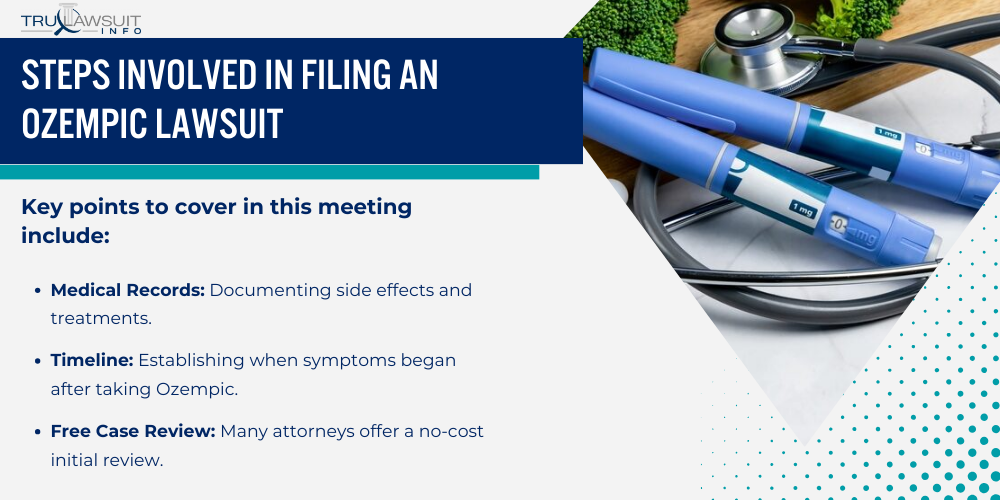
These steps usually focus on consulting attorneys and initiating the legal process correctly.
Consulting with an Experienced Ozempic Lawsuit Attorney
The initial step is to consult with an experienced Ozempic lawsuit attorney.
This consultation helps potential plaintiffs understand the legal grounds for their case.
First, they should find a lawyer with a background in prescription drug litigation.
Having an attorney who knows the intricacies of such cases can be vital to success.
During the consultation, the plaintiff’s medical history with Ozempic and any adverse effects experienced are reviewed.
Key points to cover in this meeting include:
- Medical Records: Documenting side effects and treatments.
- Timeline: Establishing when symptoms began after taking Ozempic.
- Free Case Review: Many attorneys offer a no-cost initial review.
- Legal Strategy: Planning the approach for the lawsuit.
Engaging with a knowledgeable lawyer can clarify potential outcomes and next steps.
It also ensures that the plaintiff is well-prepared for the legal process.
Initiating the Ozempic Lawsuit Process
After the initial consultation, the next step is initiating the Ozempic lawsuit process.
Filing a lawsuit involves several stages.
The plaintiff’s lawyer begins by filing a complaint with the judicial panel, outlining the claims against the manufacturer.
This complaint includes details of how the plaintiff was harmed by Ozempic, supported by the collected medical evidence.
Key stages in this process:
- Filing the Complaint: Officially documenting the lawsuit.
- Notification: Informing the defendant (e.g., drug manufacturer).
- Case Management: Setting schedules for discovery, depositions, and potential court dates.
- Discovery Phase: Exchanging evidence and building the case.
- Settlement Negotiations: Attempting to resolve the case out of court.
Throughout these steps, the Ozempic attorneys play a crucial role in representing their client’s interests and negotiating on their behalf.
Clear communication between the plaintiff and their lawyer is essential to navigate these proceedings effectively.
Statute of Limitations for Ozempic Lawsuits
The statute of limitations dictates the timeframe within which individuals must file a lawsuit against the makers of Ozempic.
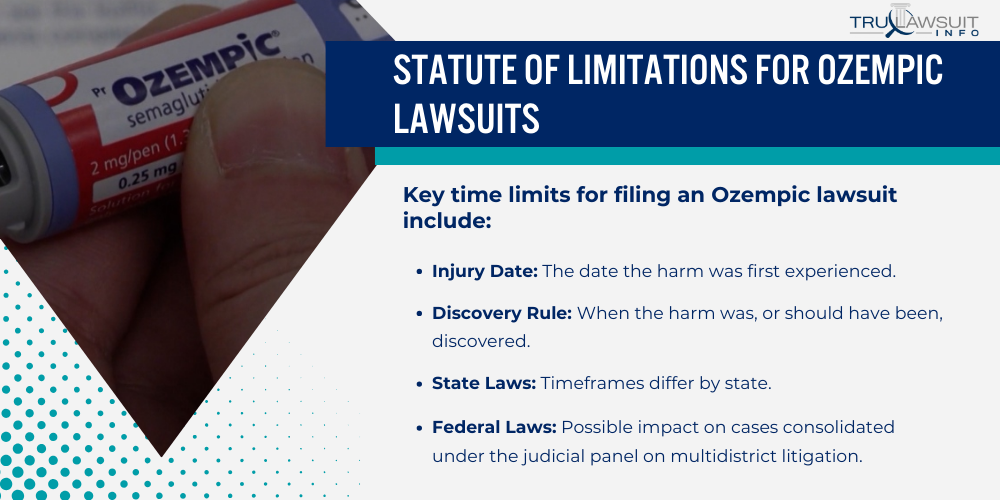
Understanding these legal deadlines and any potential exceptions can significantly impact the legal process.
Understanding Time Limits for Filing an Ozempic Lawsuit
The statute of limitations for filing an Ozempic lawsuit varies based on jurisdiction.
Generally, these time limits range from 1 to 4 years, starting from the date of injury or the date when the injury was discovered.
Key time limits for filing an Ozempic lawsuit include:
- Injury Date: The date the harm was first experienced.
- Discovery Rule: When the harm was, or should have been, discovered.
- State Laws: Timeframes differ by state.
- Federal Laws: Possible impact on cases consolidated under the judicial panel on multidistrict litigation.
Involving a law firm early can help ensure timely filings.
Legal representatives are crucial for navigating the timelines and specific rules applicable in different states.
Exceptions to the Statute of Limitations in Ozempic Lawsuits
Certain circumstances might extend or toll the statute of limitations.
Exceptions are typically specific and require legal scrutiny to apply.
Common exceptions to the statue of limitations include:
- Minority: Plaintiffs who were under 18 at the time of injury may have extended time limits.
- Mental Incapacity: Those deemed mentally incapacitated may receive extensions.
- Fraudulent Concealment: If the manufacturer concealed the injury’s cause, the statute of limitations might be tolled.
- Continuous Treatment Doctrine: Ongoing treatment delays the start of the statute of limitations period.
These exceptions are not uniformly applied and depend heavily on individual case details.
Legal advice from a specialized law firm is recommended to understand eligibility for extensions or tolling within the jurisdiction of the case.
Potential Compensation in an Ozempic Lawsuit
Individuals involved in Ozempic lawsuits may seek various forms of compensation.
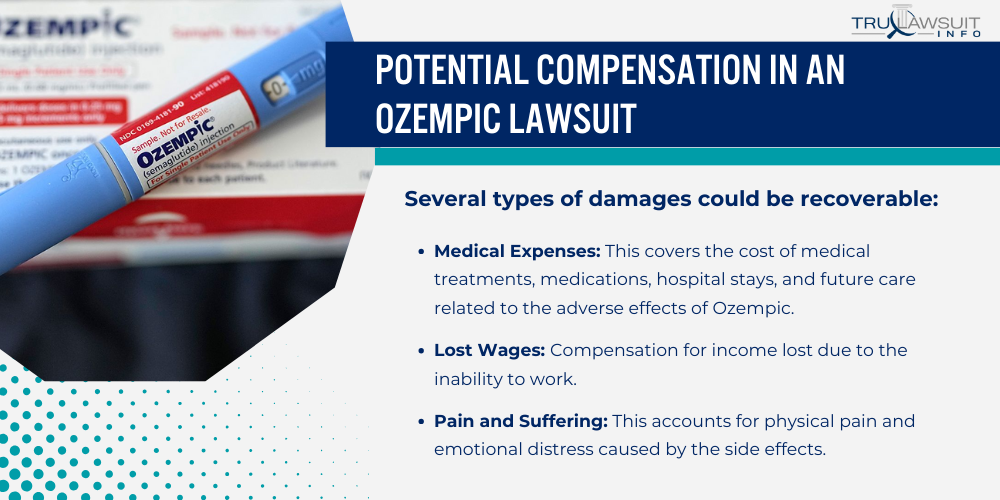
Numerous factors, ranging from the specifics of the case to the damages sustained by the plaintiff, can influence the amount and type of compensation.
Types of Damages Recoverable in Ozempic Lawsuits
Plaintiffs in Ozempic lawsuits may pursue compensatory damages to cover their losses.
Several types of damages could be recoverable:
- Medical Expenses: This covers the cost of medical treatments, medications, hospital stays, and future care related to the adverse effects of Ozempic.
- Lost Wages: Compensation for income lost due to the inability to work.
- Pain and Suffering: This accounts for physical pain and emotional distress caused by the side effects.
- Loss of Consortium: Compensation for the negative impact on the personal relationship between the plaintiff and their spouse.
In some cases, punitive damages may also be awarded.
These are meant to punish the defendant for particularly harmful behavior and to deter similar actions in the future.
Factors Influencing Ozempic Lawsuit Settlement Amounts
The settlement amounts in Ozempic lawsuits are influenced by a variety of considerations.
Understanding these factors can help plaintiffs better prepare their cases and set realistic expectations.
Settlement amounts in Ozempic cases can vary widely based on specific factors:
- Severity of Injuries: The more severe the injuries, the higher the potential compensation.
- Medical Documentation: Detailed medical records can support the claim and influence the Ozempic settlement value.
- Legal Representation: Experienced legal teams can negotiate higher settlements.
- Defendant’s Conduct: Evidence of negligence or malfeasance by Novo Nordisk may lead to increased punitive damages.
- Number of Plaintiffs: Cases with multiple plaintiffs can lead to a larger collective settlement, as is often the case in class-action lawsuits.
These factors play a significant role in determining the potential compensation a plaintiff in an Ozempic stomach paralysis lawsuit can receive.
TruLawsuit Info: Choosing the Right Ozempic Lawsuit Attorney
Selecting the right Ozempic attorney can make a significant difference in the outcome of your case.
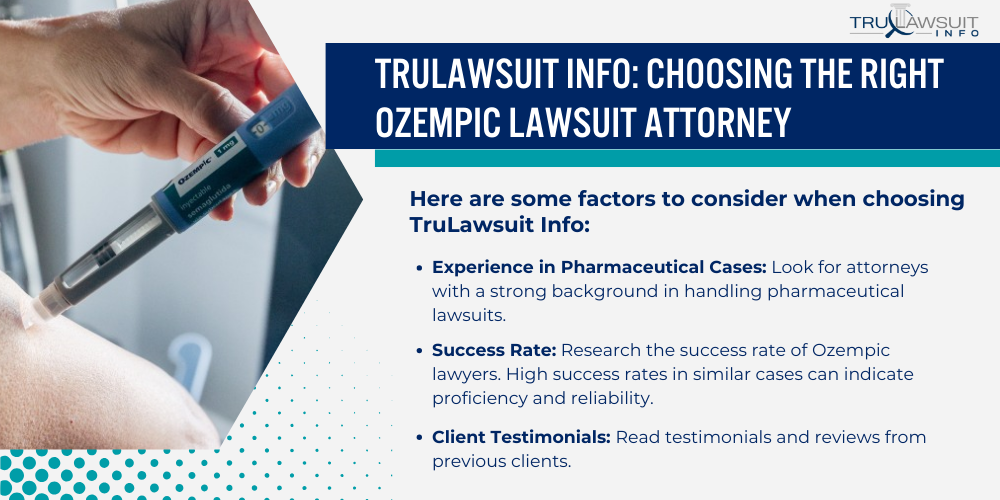
Here are some factors to consider when choosing TruLawsuit Info:
- Experience in Pharmaceutical Cases: Look for attorneys with a strong background in handling pharmaceutical lawsuits. Professionals with experience against companies like Nordisk and Eli Lilly can provide valuable insights.
- Success Rate: Research the success rate of Ozempic lawyers. High success rates in similar cases can indicate proficiency and reliability.
- Client Testimonials: Read testimonials and reviews from previous clients. Positive feedback can be a good indicator of the attorney’s capability and approach.
- Resources and Network: Check if the attorney has access to a wide network of expert witnesses and medical professionals. This can be crucial for building a strong case.
- Communication Skills: Ensure that the attorney is communicative and responsive. Regular updates and clear communication are essential for transparency.
- Fee Structure: Understand the fee arrangements before hiring. Some plaintiff lawyers might work on a contingency fee basis, meaning they get paid only if you win the case.
By considering these factors, individuals can make a more informed decision when it comes to selecting an Ozempic lawsuit attorney.
Frequently Asked Questions
-
The Ozempic lawsuit involves plaintiffs alleging severe side effects and a lack of adequate warnings from Novo Nordisk, the manufacturer.
The case has escalated to a class action lawsuit, focusing on disclosure and liability regarding the drug’s potential risks.
-
Severe reactions linked to the Ozempic lawsuit include severe gastrointestinal issues, cases of severe gastroparesis, increased risk of thyroid tumors and certain cancers, and cardiovascular risks.
These side effects have led to multiple lawsuits against the drug’s manufacturers, arguing that the Ozempic warning label did not adequately inform users of these potential dangers.
-
To support an Ozempic lawsuit claim, plaintiffs should gather medical records detailing the onset and treatment of ailments like stomach paralysis, proof of drug purchase confirming Ozempic use, expert testimonies linking adverse effects to the drug, and personal statements describing the side effects experienced.
Collecting and organizing this evidence properly can significantly impact the lawsuit’s success.
-
The steps involved in filing an Ozempic lawsuit include consulting with an experienced attorney specializing in prescription drug litigation to understand the legal grounds for the case and initiating the lawsuit process by filing a complaint with the judicial panel, outlining the claims against the manufacturer.
The plaintiff’s Ozempic lawyer plays a crucial role in representing their client’s interests and negotiating on their behalf throughout the legal proceedings.
-
Ozempic lawsuit settlement amounts can vary based on factors such as the severity of injuries, availability of detailed medical documentation, the experience of the legal representation, evidence of negligence or malfeasance by Novo Nordisk, and the number of plaintiffs involved in the case.
These factors play a significant role in determining the potential compensation a plaintiff can receive in an Ozempic lawsuit.

Attorney Jessie Paluch, founder of TruLawsuit Info, has over 25 years of experience as a personal injury and mass tort attorney, and previously worked as an international tax attorney at Deloitte. Jessie collaborates with attorneys nationwide — enabling her to share reliable, up-to-date legal information with our readers.
Legally Reviewed
This article has been written and reviewed for legal accuracy and clarity by the team of writers and legal experts at TruLawsuit Info and is as accurate as possible. This content should not be taken as legal advice from an attorney. If you would like to learn more about our owner and experienced injury lawyer, Jessie Paluch, you can do so here.
Fact-Checked
TruLawsuit Info does everything possible to make sure the information in this article is up to date and accurate. If you need specific legal advice about your case, contact our team by using the chat on the bottom of this page. This article should not be taken as advice from an attorney.
You can learn more about the Ozempic Lawsuit by visiting any of our pages listed below:
Here, at Tru Lawsuit Info, we’re committed to helping victims get the justice they deserve.
To do this, we actively work to connect them with attorneys who are experts in litigating cases similar to theirs.
Table of Contents
Tru Lawsuit Info is a reliable source of information about issues that may affect your health and safety, such as faulty products, data breaches, and environmental hazards.
Our team of experienced writers collaborates with medical professionals, lawyers, and advocates to produce informative articles, guides, and other resources that raise awareness of these topics.
Our thorough research provides consumers with access to reliable information and updates on lawsuits happening around the country. We also can connect consumers with attorneys if they need assistance.
Here, at Tru Lawsuit Info, we’re committed to helping victims get the justice they deserve.
To do this, we actively work to connect them with attorneys who are experts in litigating cases similar to theirs.
